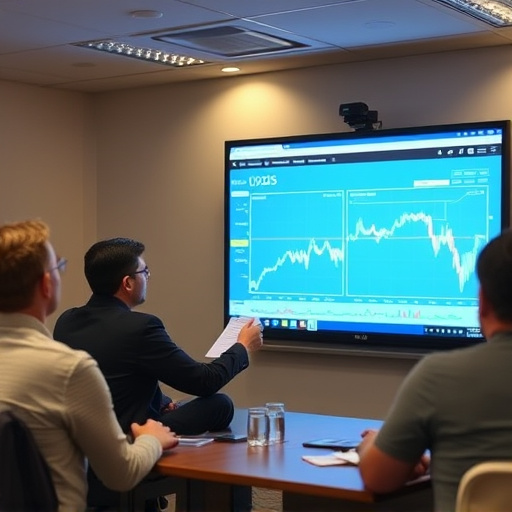In Australia, sectors like mining, agriculture, healthcare, and tech collaborate through shared training to drive growth and innovation, addressing skill gaps, enhancing productivity, and preparing workers for future demands. These initiatives aim to unlock "wealth within" industries by fostering cross-disciplinary skills, continuous learning, and knowledge transfer, ultimately boosting competitiveness and economic prosperity.
In Australia’s diverse industrial landscape, uncovering shared training opportunities is a game-changer. This article delves into the critical role of cross-sector collaboration in fostering economic growth and empowering workers. We explore training trends across sectors, uncover shared learning initiatives, and identify key skills for a prosperous future. By mapping comprehensive training programs, we reveal how collaboration is the secret to unlocking wealth within Australian industries, paving the way for a robust and adaptable workforce.
- Exploring Training Trends Across Australian Sectors
- Uncovering Cross-Industry Learning Initiatives
- Identifying Shared Skills for Economic Growth
- Collaboration: Key to Wealth Within Industries
- Mapping Training Programs for Maximum Impact
- Empowering Workers: A National Strategy Unveiled
Exploring Training Trends Across Australian Sectors

In Australia, exploring training trends across various sectors reveals a dynamic landscape where shared opportunities are abundant. Each industry has its unique challenges and demands, but many face common threads when it comes to upskilling and reskilling their workforce. From mining and agriculture to healthcare and technology, there’s a growing recognition of the value in collaborative training initiatives. These efforts aim to address skill gaps, enhance productivity, and drive innovation across sectors, ultimately fostering wealth within these industries.
By examining current trends, it becomes evident that shared training programs can leverage resources, expertise, and best practices more efficiently. For instance, technology companies can share their advanced digital training modules with manufacturing sectors eager to adopt Industry 4.0 practices. Similarly, healthcare professionals can collaborate on continuing education, benefiting from each other’s experiences in diverse clinical settings. This exchange not only broadens the skill set of workers but also accelerates Australia’s economic growth by ensuring a flexible and adaptable workforce ready to meet the demands of an ever-changing job market.
Uncovering Cross-Industry Learning Initiatives

Uncovering cross-industry learning initiatives is a vital step in identifying shared training opportunities across diverse sectors in Australia. Many Australian industries are exploring ways to collaborate and share resources, knowledge, and best practices. This trend is not only fostering innovation but also ensuring that valuable skills and expertise are accessible beyond individual industry boundaries. By joining forces, businesses can create powerful synergies, driving growth and enhancing competitiveness within the broader economy.
These collaborative efforts often take the form of joint training programs, workshops, and knowledge-sharing platforms. For instance, initiatives that bring together professionals from various sectors can lead to the development of cross-disciplinary skills, enabling individuals to contribute more effectively across multiple industries. Such initiatives also promote a culture of continuous learning and adaptability, which is crucial in today’s rapidly evolving business landscape. Moreover, uncovering these shared learning opportunities can help uncover hidden wealth within Australian industries, as knowledge and skills become more accessible and transferable.
Identifying Shared Skills for Economic Growth

In Australia, identifying shared training opportunities across industries is a strategic approach to fostering economic growth and creating a more resilient job market. By focusing on transferable skills and knowledge, businesses can collaborate to develop a pipeline of talent with the potential to drive innovation and wealth within their sectors. This collaborative effort ensures that individuals gain versatile skill sets, enhancing their employability and enabling them to adapt to evolving industry demands.
Shared training initiatives facilitate the exchange of resources and expertise, allowing for cost-effective and efficient upskilling. This approach leverages the collective knowledge of Australian industries, ultimately strengthening their global competitiveness. By investing in these programs, businesses contribute to a skilled workforce that can navigate the ever-changing economic landscape, fostering sustainability and prosperity for the nation’s diverse sectors.
Collaboration: Key to Wealth Within Industries

In Australian industries, collaboration emerges as a powerful driver for achieving what’s commonly referred to as wealth within. By fostering partnerships across different sectors and organizations, businesses can tap into diverse skill sets, resources, and perspectives, leading to innovation and growth. This shared knowledge and collaborative efforts create a dynamic environment where ideas flourish and new opportunities emerge.
Collaboration isn’t just about sharing; it’s a strategic approach that enables industries to stay competitive in an ever-evolving market. Through joint training programs, workshops, and research initiatives, Australian businesses can upskill their workforce, drive efficiency, and adapt to changing industry landscapes. This wealth within is not solely measured in monetary terms but also encompasses the intellectual capital built through collective learning and problem-solving.
Mapping Training Programs for Maximum Impact

Mapping out training programs is a strategic move for Australian industries aiming to unlock the wealth within their workforce. By meticulously aligning training initiatives with industry needs and employee skill gaps, businesses can ensure that investments in education translate into tangible improvements in productivity and performance. This process involves a comprehensive analysis of existing programs, identifying overlaps and gaps, and then designing targeted interventions that cater to specific sectoral requirements.
Such an approach fosters efficiency by avoiding redundant training while addressing critical areas of improvement. It encourages industry collaboration, where sharing best practices and resources can enhance the overall quality and reach of training opportunities. Ultimately, effective mapping paves the way for a skilled and adaptable workforce, driving Australia’s industries towards greater success and competitiveness in the global landscape.
Empowering Workers: A National Strategy Unveiled

In a bid to unlock the vast potential of Australian industries, a national strategy has been unveiled with a primary focus on empowering workers through shared training opportunities. This initiative aims to bridge skill gaps and foster a culture of continuous learning, ensuring that Australia’s workforce remains competitive in an ever-evolving global market. By facilitating access to diverse training programs, the strategy seeks to create a richer, more skilled talent pool, ultimately driving economic growth and enhancing the overall wealth within these sectors.
The strategy recognizes the importance of tailored training tailored to each industry’s unique needs, while also promoting cross-sector knowledge exchange. This collaborative approach allows workers to gain specialized skills relevant to their fields, as well as transferable competencies that can open doors to new career paths. With a national framework in place, Australian industries are poised to navigate challenges and capitalize on emerging trends, ensuring a resilient and adaptable workforce capable of driving innovation and prosperity.
In conclusion, identifying shared training opportunities across Australian industries is a strategic move towards fostering economic growth and ensuring a prosperous future. By leveraging cross-industry learning initiatives and mapping comprehensive training programs, we can empower workers with the necessary skills to thrive in a competitive global landscape. Collaboration among sectors is key to unlocking the potential of Australia’s workforce, leading to sustainable wealth within and beyond industries.
